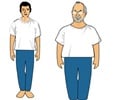Seeing a thin human-like shape leads consumers with a high body mass index to make more indulgent decisions.

Mere reminders of the thin-body ideal can cause overweight consumers to feel worse about their own abilities, besides reducing their capability of managing their spending impulses.
In one study where consumers were shown an object with a thin, human-like shape (much like a Coca-Coca bottle), high-BMI consumers were more likely to buy a higher-priced, Fiji-brand bottle of water than a lower-priced, generic-brand bottle.
Another study on shopping found that high-BMI consumers were more willing to take on credit card debt after seeing a thin (vs. wide) shape because they felt less capable of managing their spending impulses.
"In our research, we show that exposure to body cues (i.e., shapes) can have unintended consequences on seemingly unrelated behavior, such as spending," write authors Marisabel Romero (Colorado State University) and Adam W. Craig (University of Kentucky). "We demonstrate that seeing a thin (vs. wide) human-like shape leads high-body-mass-index consumers to make more indulgent spending decisions."
These findings suggest that consumer advocates should be wary of reinforcing the link between weight, self-control, and financial achievement, as doing so can be counterproductive. The implications are particularly important given the negative consequences such messages could have on consumer debt and spending.
Advertisement
Source-Eurekalert












